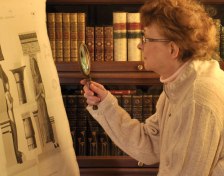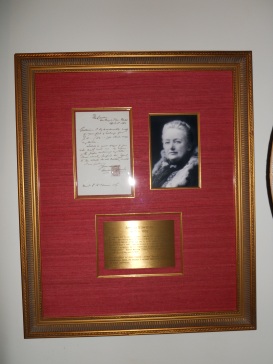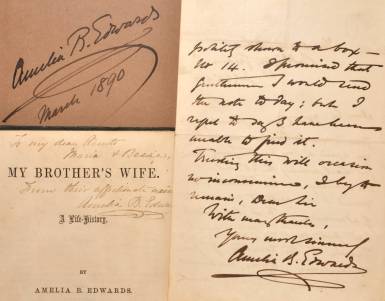In response to our post about bookshelves — and the challenge issued by Bookshelf Battles — we are getting some interesting messages from fans of MPM (aka Barbara). From two faithful fans and readers comes this interesting entry: a picture of Amelia B. Edwards (an early explorer in Egypt) resting on a bookshelf that has some of her books and letters. Like Barbara, and her heroine Amelia Peabody, Amelia B. Edwards fell in love with the art and history of ancient Egypt, and became very involved in preservation efforts. Less known about Edwards was her mystery-writer career, for as William Joy explains, in addition to her travel writings and Egyptological works, she was also a musician, artist, newspaper journalist, poet, short story writer (ghost stories and mysteries!), a novelist, and also a contributor to a children’s book recently discovered, which had been absent from her bibliographies.
The Edwards items on this shelf come from the Egyptology Library of Peggy Joy, a Michigan native and ardent amateur Egyptologist. According to her son William who has been assembling the library: “It’s a continual work in progress, but Amelia B. Edwards has always been a subject of very special interest, and is well represented.” Amelia’s first important travel book (and which served as a model for her later work on Egypt) was: Untrodden Peaks and Unfrequented Valleys: A Midsummer Ramble in the Dolomites, first issued in 1873; it can be seen on the far right in the bookshelf picture, with a green binding. To its left are a pair of second editions with variant color bindings (typical for Amelia’s books in 1890, when these were issued). Amelia’s magnum opus: A Thousand Miles Up The Nile, which recounted her time in Egypt in 1873–74, was first issued in 1877 (a copy can be seen on the far left). When the second edition appeared (at the same time as the second issue of Untrodden Peaks…), the bindings for both titles were elaborately decorated using the author’s own illustrations; one such copy of A Thousand Miles… can be seen second from left in the picture. To the right of this is a slender volume entitled: The Queen of Egyptology, an early biography of Amelia by the American William Winslow, from 1892. In the foreground, an 1880 letter (hand-written by Amelia) describes her enthusiasm and happiness over the success of what would prove to be her final, but most successful novel: Lord Brackenbury . By the beginning of the next year (and for the remainder of her life), Amelia’s entire attention focused on nothing but ancient Egypt, thus ending her career as a fiction writer. In the winter of 1889–90, Amelia made a tour of American cities, where she lectured on ancient Egyptian subjects. These were subsequently reproduced in print form in Pharaohs, Fellahs and Explorers, a first edition of which can be seen in the middle of the picture.
The portrait of Amelia on the shelf also comes from the time of her American tour. It was taken as soon as she arrived in the United States, at the beginning of November, 1889 (– and notice that she’s wearing her fur-lined coat to ward off New York’s cold winter air!) This portrait was made by the photographer Napoleon Sarony, one of New York City’s more notable eccentrics, and a great friend of the American author Samuel Clemens (“Mark Twain”), who subsequently became something of a “groupie” for Amelia, following her from town to town, and treating her to dinners. Clemens had a great interest in Egypt, and published his own travel book recounting his time in the Near East: Innocents Abroad, which proved to be the best selling of all his books, during his lifetime. (Barbara was a huge fan of Twain, and was known to cite Innocents Abroad especially when in the company of those of us she suspected had not read it despite her many hints that we should…..)
Below are pics of: (1) Barbara’s own Amelia B. Edwards display with photo and letter; (2) An Edwards “signatures photo” from the Joy collection; and (3) Peggy Joy enjoying her Egyptology library:
The Egyptology Library for his mo ther is the second William Joy has assembled — here’s an interview with him about the first (a library of general history, literature and art). In this photo Mrs. Joy is examining one of the enormous pages from the famed French publication Description de l’Égypte (1809–29). Her copy once belonged to Egypt’s King Farouk; a circular purple ink stamp in the middle of the right margin reads (translated from Arabic): “From the library of the office of His Excellency the King.” Books on the shelves behind her include Gaston Maspero’s voluminous History of Egypt, atop which rests a first edition of Dr. Thomas Young’s An Account of Some Recent Discoveries in Hieroglyphical Literature (1823). Also visible are the first two volumes of a vellum-bound set of Herodotus, as translated by George Rawlinson (with assistance from the Egyptologist Sir John Gardner Wilkinson). Other sets in the picture include Rollin’s The Ancient History of the Egyptians… and the first complete English translation of Bourrienne’s important, if controversial: The Life of Napoleon Bonaparte.
ther is the second William Joy has assembled — here’s an interview with him about the first (a library of general history, literature and art). In this photo Mrs. Joy is examining one of the enormous pages from the famed French publication Description de l’Égypte (1809–29). Her copy once belonged to Egypt’s King Farouk; a circular purple ink stamp in the middle of the right margin reads (translated from Arabic): “From the library of the office of His Excellency the King.” Books on the shelves behind her include Gaston Maspero’s voluminous History of Egypt, atop which rests a first edition of Dr. Thomas Young’s An Account of Some Recent Discoveries in Hieroglyphical Literature (1823). Also visible are the first two volumes of a vellum-bound set of Herodotus, as translated by George Rawlinson (with assistance from the Egyptologist Sir John Gardner Wilkinson). Other sets in the picture include Rollin’s The Ancient History of the Egyptians… and the first complete English translation of Bourrienne’s important, if controversial: The Life of Napoleon Bonaparte.
The signatures photo shows examples of the characteristically flamboyant flourish Amelia enjoyed placing below her name. The earliest above (1855) is from a presentation copy of her very first novel My Brother’s Wife, inscribed: “To my dear Aunts Maria & Bessie, from their affectionate niece, Amelia B. Edwards.” The closing of a letter to the English theatrical impresario John Hollingshead, manager of the enormously popular “Gaiety Theatre,” in London’s West End (where Charles Dickens would watch plays; he was also an early and eager supporter of Amelia B. Edwards, and published many of her stories) is from 1877. (Mr. Hollingshead was actually the person who introduced Gilbert and Sullivan to each other…!) The latest of the signatures appears on the back of one of Amelia’s photographs, signed for a fan in Boston, at the end of her American tour, in 1890.



August 29, 2015 at 5:33 pm
Absolutely happy to see that Barbara’s memory will live on. She inspired myself and many others. Temples, Tombs and Hieroglyphs is always the first book I recommend. I own all the Amelia Peabody books and adore Amelia Edwards. I also have the privilege of knowing the Joy family, it is great to see so many names I recognize in this article!
LikeLiked by 1 person
August 31, 2015 at 5:12 am
Thank you for your wonderful comment! It’s so great to hear of continued affection and respect for her.
LikeLike
August 8, 2020 at 6:03 am
Since I completed Children of the Storm, I’ve been agonized by the question, “What happened next!!? Did Barbara Mertz leave behind any notes, clues, hints? Does Seth/Sethos find his Grandson? Does he rescue him from Bertha’s criminal group? Bertie gathers courage to go with Sethos, does he have feelings strong enough to wed Maryam, and raise the Child? What happens to them all? Oh please, doesn’t anybody know?
LikeLike